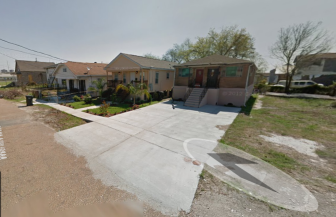For the last few years I have taken an interest in the curious phenomenon of sidewalk intrusion by car. The manner of reporting and combatting the scourge varies with the agency addressing the issue.
Most front yard paving is free-style here in New Orleans, the work of a weekend warrior with a vision — and a concrete mixer. Sometimes the city steps in and the violators get hauled before the Board of Zoning Adjustments where their fate is decided by a well-intentioned group of volunteers.
The defense of paved lawns ranges from concern for the elderly to fear of assault during the walk from a curbside space. The overarching reason for a lot of it — personal convenience at the expense of one’s neighbors — is less often acknowledged.
The city promotes itself as a “walkable city” even dedicating a page to this theme on the Convention and Visitors Bureau website. But the ability to navigate the sidewalks as a pedestrian can sometimes seem more difficult than navigating it with a car. Not to mention the risk of street flooding in a low-lying city that needs every inch of porous soil to absorb our torrential rains.
There has been a lot of advocacy regarding bike safety and bike lanes here in New Orleans. Advocacy on behalf of pedestrians? Not so much — despite our being a decent 16 on a list of the 50 U.S. cities with the most households without a car.
Ever since I started to write about the issue, readers have channeled a steady stream of complaints my way.
I hear from people who can no longer find on-street parking near their homes because non-permitted driveways have captured space previously available.

I get complaints from people fighting storm runoff. One man in the Hoffman Triangle told me he trucks in fill at least twice a year to mitigate the loss to his lawn and garden from the river of water flowing from his neighbor’s 100 percent-paved front yard.
I get complaints from people who live near universities and can no longer park as conveniently as they once did because landlords are converting single-family homes to quasi-boarding houses. Every tenant has a car, making curbside parking spaces as rare as fresh crawfish in August.
More suburban neighborhoods — Gentilly and eastern New Orleans, for example — have not been spared. In many houses elevated since Hurricane Katrina, former garages have been converted to living space. That cuts short the driveway, pushing parked cars back toward the street, blocking the sidewalk.
Runoff, esthetics and parking convenience aren’t the only issues. Public safety is another concern when lines of demarcation between pedestrian and vehicular space get blurred. An article in Atlantic Cities reported on multiple incidents in which sidewalk pedestrians in New York City have died after drivers jumped the curb. If that’s not as big a concern here, it’s only because potholes in our wretchedly maintained streets are natural speed bumps — unless you’re veering to avoid one and wind up on the sidewalk anyway.
In Brooklyn it’s neighbors vs. neighbors as residents pave their small front lawns and try to block curbside parking even without permitted curb cuts. In the borough’s Carroll Gardens district it’s cars vs. greenery. The district is eating away at the very feature that gives it its name.
London has a problem. So does Kiev. A letter to the editor of Kyiv Post, Ukraine’s leading English-language newspaper, bemoans sidewalk parking and the lack of an enforcement crackdown. “It would be so nice to see a fleet of towing trucks, constantly cruising around the city on the lookout for illegally parked vehicles,” the reader writes.
New Orleans On Line lists various parking violations that can get your car towed, and sidewalk parking in among them. But don’t hold your breath. Outside tourist-rich areas of the city, the sight of a tow truck hitching up a car parked on a sidewalk or illegally paved lawn is as rare as a unicorn.
To address the issue the Urban Conservancy is holding a public forum entitled “What’s Wrong with This Picture.” It’s at Propeller, 4035 Washington Ave., on Thursday, from 5:30 to 7 p.m.
Come early. Park legally!
The panelists:
- Dale Thayer, City Planning Commission senior environmental planner
- Ramiro Diaz, Waggonner & Ball Architects
- Jeff Supak, Global Green’s wetlands coordinator
- Travis Martin, a UNO grad student in planning and an intern with the Urban Conservancy
- Karen Gadbois, founder and investigative reporter, The Lens

